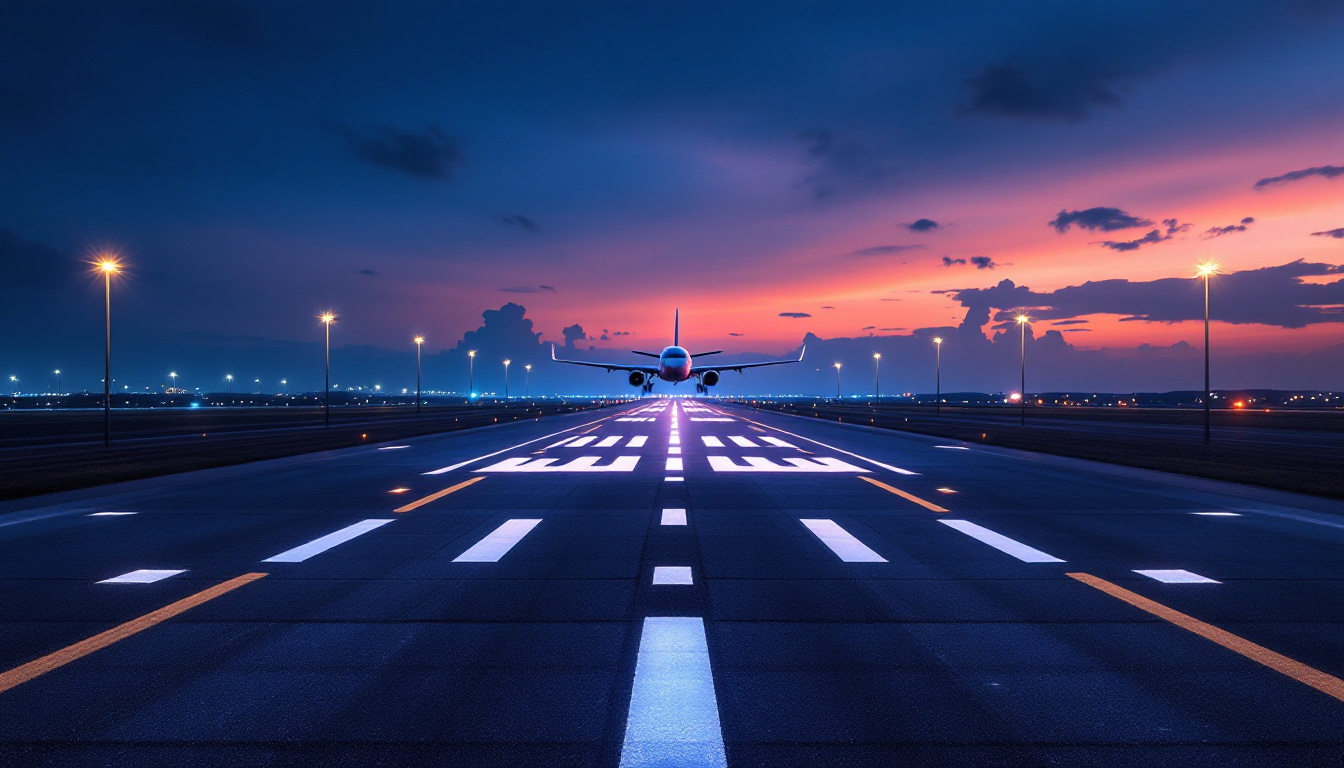
Airport lighting is a critical component of aviation safety and efficiency. For lighting contractors, understanding the specific requirements and standards associated with airport lighting is essential for successful project execution. This article will delve into the various aspects of airport lighting, including its types, regulations, and installation considerations, providing contractors with the knowledge they need to excel in this specialized field.
Airport lighting plays a vital role in ensuring the safety of aircraft during takeoff, landing, and taxiing. Proper illumination helps pilots navigate runways and taxiways, especially during low visibility conditions such as fog, rain, or nighttime operations. Moreover, effective lighting systems enhance the overall efficiency of airport operations, contributing to timely departures and arrivals.
In addition to safety and operational efficiency, airport lighting also impacts the aesthetic appeal of an airport. Well-designed lighting can enhance the visual experience for passengers and create a welcoming atmosphere. As a lighting contractor, understanding the dual role of airport lighting—functional and aesthetic—can set your work apart from competitors.
Runway and taxiway lighting systems are designed to guide pilots during critical phases of flight. Runway edge lights are typically white, while taxiway lights are blue. These lights are essential for marking the boundaries of runways and taxiways, helping pilots maintain proper alignment during landing and takeoff.
Additionally, runway threshold lights indicate the beginning of the usable runway for landing aircraft, while approach lights aid in visual guidance during the final approach. Understanding the specific color codes and configurations of these lights is crucial for contractors involved in airport lighting projects.
Obstruction lighting is necessary for marking tall structures near airports, such as communication towers and buildings. These lights help prevent collisions by making these structures visible to pilots during flight. Typically, obstruction lights are red or white, depending on the height and location of the obstacle.
Contractors must be aware of the regulations governing obstruction lighting to ensure compliance. The Federal Aviation Administration (FAA) provides guidelines on the placement, intensity, and type of lights required for various structures, making it essential for contractors to stay informed about these standards.
The apron and ramp areas of an airport are where aircraft are parked, loaded, and unloaded. Adequate lighting in these areas is crucial for the safety of ground crew and aircraft operations. Apron lighting typically consists of high-intensity floodlights that provide uniform illumination across the entire area.
Contractors should consider the layout and operational needs of the airport when designing apron lighting systems. Factors such as the size of the aircraft, ground handling equipment, and pedestrian traffic must be taken into account to ensure optimal safety and efficiency.
Compliance with regulatory standards is a fundamental aspect of airport lighting projects. The FAA and other aviation authorities set forth guidelines that dictate the design, installation, and maintenance of airport lighting systems. These regulations ensure that lighting systems meet safety and operational requirements.
Contractors should familiarize themselves with the relevant FAA Advisory Circulars, which provide detailed information on lighting design standards. Understanding these regulations not only helps in the successful completion of projects but also minimizes the risk of costly rework or penalties.
FAA Advisory Circulars outline the technical standards for airport lighting systems, including specifications for light intensity, color, and placement. For example, AC 150/5345-46 provides guidelines for runway and taxiway lighting, while AC 150/5345-53 focuses on the design of airport lighting systems.
Contractors must ensure that their designs adhere to these guidelines to achieve FAA approval. This may involve conducting photometric analyses to verify that the proposed lighting meets the required intensity levels and distribution patterns.
In addition to federal regulations, contractors must also be aware of local regulations and permitting requirements. Different jurisdictions may have specific rules governing airport lighting, including zoning laws and environmental considerations. Engaging with local authorities early in the project can help streamline the permitting process and avoid potential delays.
It is advisable for contractors to establish relationships with local regulatory agencies to stay informed about any changes in regulations that may affect airport lighting projects. This proactive approach can enhance project efficiency and ensure compliance with all necessary standards.
Designing an effective airport lighting system requires careful consideration of various factors. Contractors must assess the specific needs of the airport, including its size, layout, and operational requirements. Additionally, environmental factors such as weather conditions and surrounding terrain can influence lighting design.
One of the key considerations in airport lighting design is achieving uniform illumination. This ensures that all areas are adequately lit, reducing the risk of accidents and improving overall safety. Contractors should utilize photometric software to model lighting designs and predict how light will distribute across different areas of the airport.
In recent years, there has been a growing emphasis on energy efficiency and sustainability in airport lighting design. Contractors are encouraged to explore energy-efficient lighting options, such as LED fixtures, which consume less energy and have a longer lifespan compared to traditional lighting technologies.
Implementing smart lighting controls can also enhance energy efficiency by allowing for adaptive lighting based on real-time conditions. For example, dimming lights during low-traffic periods can significantly reduce energy consumption while maintaining safety standards.
Airport lighting systems often need to integrate with other airport infrastructure, such as air traffic control systems and weather monitoring stations. This integration is crucial for ensuring that lighting conditions are adjusted based on real-time data, enhancing safety and operational efficiency.
Contractors should collaborate with other stakeholders, including airport operators and engineers, to develop a comprehensive lighting plan that aligns with the overall airport infrastructure. This collaborative approach can lead to more effective lighting solutions and improved project outcomes.
Proper installation of airport lighting systems is essential for ensuring their functionality and longevity. Contractors should adhere to best practices during the installation process to minimize the risk of issues arising after the project is completed.
One of the key best practices is conducting thorough site assessments before installation. This includes evaluating soil conditions, drainage patterns, and potential obstacles that may affect the placement of lighting fixtures. Additionally, ensuring that all electrical components are installed according to industry standards is crucial for the safety and reliability of the lighting system.
After installation, thorough testing and commissioning of the lighting system are necessary to verify that it meets all performance standards. This may involve conducting photometric tests to assess light intensity and distribution, as well as ensuring that all components are functioning correctly.
Contractors should develop a comprehensive testing plan that outlines the specific tests to be conducted and the criteria for success. Documenting the results of these tests is essential for demonstrating compliance with regulatory standards and for future reference.
Once the lighting system is operational, ongoing maintenance is crucial for ensuring its continued performance. Contractors should establish a maintenance schedule that includes regular inspections, cleaning, and repairs as needed. This proactive approach can help identify potential issues before they escalate, ensuring that the lighting system remains reliable and effective.
Additionally, contractors should educate airport personnel on the importance of maintenance and provide them with the necessary training to carry out routine checks. Empowering airport staff to take an active role in maintenance can enhance the longevity of the lighting system and contribute to overall safety.
The field of airport lighting is continually evolving, driven by advancements in technology and changing industry standards. Contractors should stay informed about emerging trends that may impact their work and the future of airport lighting.
One notable trend is the increasing use of smart lighting systems that leverage Internet of Things (IoT) technology. These systems can provide real-time data on lighting performance, allowing for more efficient management and maintenance. Additionally, the integration of artificial intelligence can enhance decision-making processes related to lighting operations.
As safety remains a top priority in aviation, new lighting technologies are being developed to enhance safety features at airports. For instance, advanced LED systems can be equipped with sensors that detect weather conditions and adjust lighting accordingly. This adaptability can significantly improve visibility during adverse weather, contributing to safer operations.
Contractors should keep an eye on these innovations and consider how they can incorporate them into their designs. By staying at the forefront of technology, contractors can offer cutting-edge solutions that meet the evolving needs of airports and enhance overall safety.
Collaboration among industry stakeholders is becoming increasingly important in the field of airport lighting. Contractors are encouraged to build partnerships with manufacturers, engineers, and airport authorities to foster innovation and share best practices.
Participating in industry conferences and workshops can provide valuable networking opportunities and insights into the latest trends and technologies. By engaging with other professionals in the field, contractors can enhance their knowledge and stay competitive in the ever-evolving landscape of airport lighting.
Airport lighting is a complex and specialized field that requires a deep understanding of safety regulations, design principles, and installation best practices. For lighting contractors, mastering these aspects is essential for delivering successful projects that meet the needs of airports and enhance aviation safety.
By staying informed about regulatory standards, embracing innovative technologies, and prioritizing collaboration, contractors can position themselves as leaders in the airport lighting industry. As the aviation landscape continues to evolve, so too will the opportunities for contractors to contribute to safer and more efficient airport operations.
Ready to elevate your airport lighting installations with the highest quality products at the best value? Look no further than LumenWholesale for spec-grade lighting solutions that meet rigorous industry standards. Our extensive selection is designed to support the safety and efficiency of your airport lighting projects, all at unbeatable wholesale prices. With free shipping on bulk orders, you can trust that you’re getting premium lighting without hidden fees or compromises. Choose LumenWholesale for a seamless blend of quality, affordability, and convenience, and light up your next aviation project with confidence.

Discover how LED light bulbs can transform your recessed lighting into an energy-efficient and stylish solution.

Discover the intricacies of smart switch 4-way installations tailored for lighting contractors.

Illuminate your outdoor spaces with expert insights from our comprehensive guide on lamp posts.

Discover the essential considerations for lighting contractors when installing low voltage under counter lighting.